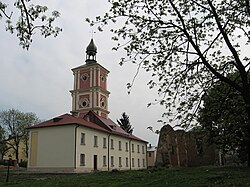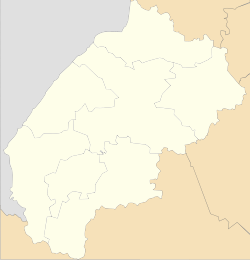|
Belz
Belz (Ukrainian: Белз, IPA: [bɛlz] ⓘ; Polish: Bełz; Yiddish: בעלז) is a small city in Lviv Oblast, western Ukraine, located near the border with Poland between the Solokiya River (a tributary of the Bug River) and the Richytsia stream. Belz hosts the administration of Belz urban hromada, one of the hromadas of Ukraine.[1] Its population is approximately 2,191 (2022 estimate).[2] Origin of nameThere are a few theories as to the origin of the name:
The name occurs only in two other places, the first being a Celtic area in antiquity, and the second one being derived from its Romanian name:
HistoryHistorical affiliations
Early historyBelz is situated in a fertile plain which tribes of Indo-European origin settled in ancient times: Celtic Lugii,[3][4] next (2nd-5th century) Germanic Goths,[5][6] slavized Sarmatians (White Croats),[7] and at last Slavic Dulebes[8] (later Buzhans), who eventually become part of the Kievan Rus' in 907, when Dulebs took part in Oleg's military campaign against Czargrad (Constantinople).[9] Mainly рolish historiography located here also Lendians tribe[10] whо also paid tribute to Kievan Rus'.[11] The town has existed at least since the 10th century as one of the Cherven Cities[12] which were under Polish rule in the 970s.[13] In 981 Belz was incorporated into Kievan Rus'.[14] In 1170, the town became the seat of a duchy. In 1234 it was incorporated into the Duchy of Galicia–Volhynia, which would control Belz until 1340 when it came under Lithuanian rule. Belz was under Polish rule from 1366 to 1772, first as a fief, and since 1462 as the capital of a voivodeship. On October 5, 1377, the town was granted rights under the Magdeburg law by Władysław Opolczyk, the governor of Red Ruthenia. A charter dated November 10, 1509 once again granted Belz privileges under the Magdeburg rights.[15] In 1772, Belz was incorporated into the Habsburg Empire (later Austrian Empire and Austro-Hungarian Empire) where it was a part of the Kingdom of Galicia and Lodomeria. Belz received a railway connection in 1884 with the opening of the railway line Jarosław–Kowel.[16] Modern historyWith the collapse of Austria-Hungary following World War I in November 1918, Belz was included in the Western Ukrainian People's Republic. It came under Polish control in 1919 during the Polish-Ukrainian War. In April 1920, the Second Polish Republic, represented by Józef Piłsudski, and the Ukrainian People's Republic, represented by Symon Petlura signed the Treaty of Warsaw, in which they agreed that the Polish-Ukrainian border in Western Ukraine would follow the Zbruch River. This left Belz, along with the rest of Eastern Galicia in the Polish Republic.[17] From 1919 to 1939 Belz was annexed to the Lviv Voivodeship, Second Polish Republic. From 1939 to 1944 Belz was occupied by Germany as a part of the General Government. Belz is situated on left, north waterside of the Solokiya river (affluent of the Bug river), which was the German-Soviet border in 1939–1941. During the war, the delegation of the Hrubeshiv Ukrainian Relief Committee operated in the city.[18] After the war Belz reverted to Poland (where it was again within the Lublin Voivodeship) until 1951 when, after a border readjustment, it passed to the Soviet Union (Ukrainian Soviet Socialist Republic). (See: 1951 Polish–Soviet territorial exchange) Since 1991 it has been part of independent Ukraine. Until 18 July 2020, Belz belonged to Sokal Raion. The raion was abolished in July 2020 as part of the administrative reform of Ukraine, which reduced the number of raions of Lviv Oblast to seven. The area of Sokal Raion was merged into Chervonohrad Raion (modern Sheptytskyi Raion).[19][20] Jewish history The Ashkenazi Jewish community in Belz was established circa 14th century. In 1665, the Jews in Belz received equal rights and duties.[21] The town became home to a Hasidic dynasty in the early 19th century.[22][23] The Rabbi of Belz, Shalom Rokeach (1779–1855), also known as the Sar Shalom, joined the Hasidic movement by studying with the Maggid of Lutzk,[24] and established the community and become the first Belzer Rebbe, thereby establishing the Belz Hasidic dynasty. When Rebbe Shalom died in 1855, his youngest son, Rebbe Yehoshua Rokeach (1855–1894), became the next Rebbe. Belzer Hasidism grew in size during the tenure of Rebbe Yehoshua's son and successor, Rebbe Yissachar Dov Rokeach (third Belzer Rebbe)(1894–1926). Rebbe Yissachar Dov's son and successor, Rebbe Aharon Rokeach (1880 to 1957), escaped from Nazi-occupied Europe to Israel in 1944, re-establishing the Hasidut first in Tel Aviv and then in Jerusalem. For recent history see Belz (Hasidic dynasty) § Belz today. At the beginning of World War I, Belz had 6100 inhabitants, including 3600 Jews, 1600 Ukrainians, and 900 Poles.[25] During the German and Soviet invasion of Poland (September 1939), most of the Jews of Belz fled to the Soviet Union in Autumn 1939 (the German–Soviet Treaty of Friendship, Cooperation and Demarcation). However, by May 1942, there were over 1,540 local Jewish residents and refugees in Belz. On June 2, 1942, 1,000 Jews were deported to Hrubieszów and from there to Sobibor extermination camp. Another 504 were brought to Hrubieszów in September of that year, after they were no longer needed to work on the farms in the area.[26] Cultural triviaThe Yiddish song “Beltz, Mayn Shtetele” is a moving evocation of a happy childhood spent in a shtetl. Originally this song was composed for a town which bears a similar-sounding name in Yiddish (belts), called Bălți in Moldovan/Romanian, and is located in Bessarabia[27] (presently the Moldova Republic). Later interpretations may have had Belz in mind, though.[citation needed] The song has special significance in Holocaust history, as a 16-year-old playing the song was overheard by an SS guard at Auschwitz extermination camp, who then forced the child to play it repeatedly to ease the moods of Jews being herded into the gas chambers.[citation needed] Belz is also a very important place for Ukrainian Catholics and Polish Catholics as a place where the Black Madonna of Częstochowa (this icon was believed to have been painted by St. Luke the Evangelist) had resided for several centuries until 1382, when Władysław Opolczyk, duke of Opole, took the icon home to his principality after ending his service as the Royal emissary for Halychyna for Louis I of Hungary.[28] Literature – Belles-lettres: a poem Maria: A Tale of the Ukraine written by Antoni Malczewski, and a novel Starościna Bełska: opowiadanie historyczne 1770–1774 by Józef Ignacy Kraszewski. Notable people  
See alsoReferences
Further reading
External linksWikimedia Commons has media related to Belz.
|
||||||||||||||||||||||||||||||||||||||||||
Portal di Ensiklopedia Dunia





